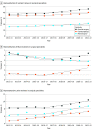Assessment of Demographic Changes of Workforce Diversity in Otolaryngology, 2013 to 2022
- PMID: 37261840
- PMCID: PMC10236323
- DOI: 10.1001/jamaoto.2023.1130
Assessment of Demographic Changes of Workforce Diversity in Otolaryngology, 2013 to 2022
Abstract
Importance: Given the growth of minoritized groups in the US and the widening racial and ethnic health disparities, improving diversity remains a proposed solution in the field of otolaryngology. Evaluating current trends in workforce diversity may highlight potential areas for improvement.
Objective: To understand the changes in gender, racial, and ethnic diversity in the otolaryngology workforce in comparison with changes in the general surgery and neurosurgery workforces from 2013 to 2022.
Design, setting, and participants: This cross-sectional study used publicly available data from the Accreditation Council for Graduate Medical Education and the Association of American Medical Colleges for 2013 to 2022, and included medical students and trainees in all US medical residency programs and allopathic medical schools.
Main outcomes and measures: Average percentages of women, Black, and Latino trainees during 2 intervals of 5 years (2013-2017 and 2018-2022). Pearson χ2 tests compared demographic information. Normalized ratios were calculated for each demographic group in medical school and residency. Piecewise linear regression assessed linear fit for representation across time periods and compared rates of change.
Results: The study population comprised 59 865 medical residents (43 931 [73.4%] women; 6203 [10.4%] Black and 9731 [16.2%] Latino individuals; age was not reported). The comparison between the 2 study intervals showed that the proportions of women, Black, and Latino trainees increased in otolaryngology (2.9%, 0.7%, and 1.6%, respectively), and decreased for Black trainees in both general surgery and neurosurgery (-0.4% and -1.0%, respectively). In comparison with their proportions in medical school, Latino trainees were well represented in general surgery, neurosurgery, and otolaryngology (normalized ratios [NRs]: 1.25, 1.06, and 0.96, respectively); however, women and Black trainees remained underrepresented in general surgery, neurosurgery, and otolaryngology (women NRs, 0.76, 0.33, and 0.68; Black NRs, 0.63, 0.61, and 0.29, respectively). The percentage of women, Black, and Latino trainees in otolaryngology all increased from 2020 to 2022 (2.5%, 1.1%, and 1.1%, respectively). Piecewise regression showed positive trends across all 3 specialties.
Conclusions and relevance: The findings of this cross-sectional study indicate a positive direction but only a modest increase of diversity in otolaryngology, particularly in the context of national demographic data. Novel strategies should be pursued to supplement existing efforts to increase diversity in otolaryngology.
Conflict of interest statement
Figures


References
-
- Association of American Medical Colleges . Statement on Police Brutality and Racism in America and Their Impact on Health. Accessed April 27, 2023. https://www.aamc.org/news-insights/press-releases/aamc-statement-police-...

